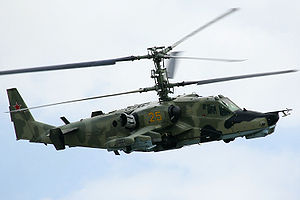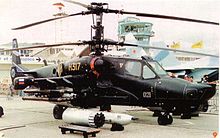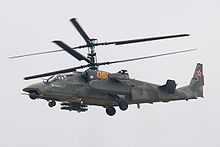Kamov Ka-50 Video - Picture

|
|
Kamov Ka-50
Ka-50 "Black Shark"
Ka-52 "Alligator"

Aircraft Picture - Kamov Ka-50 of the Russian Air Force (VVS)
Role: Attack helicopter
National origin: Soviet Union / Russia
Manufacturer: Kamov
First flight: 17 June 1982
Introduction: 28 August 1995
Status: Limited service
Primary user: Russian Air Force (VVS)
Number built: Ka-50: 15 as of 2006
Ka-52: 10 as of 2006
Unit cost: 500 million rubles (approx. $16 million) as of May 2011
Google's machine translation may provide useful guidance. (Do not simply copy-paste this machine translation, however.)
Do not translate text that appears unreliable or low-quality. If possible, verify the text with references provided in the foreign-language article.
After translating, {{Translated|ru|corresponding article}} must be added to the talk page to ensure copyright compliance.
For more guidance, see Wikipedia:Translation.
The Kamov Ka-50 "Black Shark" (Russian: ЧÑÑÐ½Ð°Ñ Ð°ÐºÑла; Chornaya Akula Black Shark, NATO reporting name: Hokum A) is a single-seat Russian attack helicopter with the distinctive coaxial rotor system of the Kamov design bureau. It was designed in the 1980s and adopted for service in the Russian army in 1995. It is currently manufactured by the Progress company in Arsenyev.
During the late 1990s, Kamov and Israel Aerospace Industries developed a tandem-seat cockpit version, the Kamov Ka-50-2 "Erdogan", to compete in Turkey's attack helicopter competition. Kamov also designed another two-seat variant, the Kamov Ka-52 "Alligator" (Russian: ÐллигаÑоÑ, NATO reporting name: Hokum B).
Development
The Ka-50 is the production version of the V-80Sh-1 prototype. Production of the attack helicopter was ordered by the Soviet Council of Ministers on 14 December 1987. Development of the helicopter was first reported in the West in 1984. The first photograph appeared in 1989. Following initial flight testing and system tests the Council ordered the first batch of helicopters in 1990. The attack helicopter was first described publicly as the "Ka-50" in March 1992 at a symposium in the United Kingdom.
The helicopter was publicly unveiled at the Mosaeroshow '92 at Zhukovskiy, in August 1992. The following month, the second production example made its foreign debut at the Farnborough Airshow, where it was displayed with an image of a werewolf on its rudder-gaining the popular nickname "Werewolf". The fifth prototype gave the Ka-50 a particularly enduring designation. Painted black for its starring role in the movie ЧÑÑÐ½Ð°Ñ Ð°ÐºÑла/Black Shark, the helicopter has been known by that nickname ever since. In November 1993, four production helicopters were flown to the Army Aviation Combat Training Centre at Torzhok to begin field trials. The president of the Russian Federation authorized the fielding of the Ka-50 with the Russian Army on 28 August 1995. The collapse of the Soviet Union led to a severe drop in defense procurement. This resulted in a mere dozen Ka-50s instead of the planned several hundred being delivered, meaning that there was still no proper replacement for the Mi-24.
The Ka-50 was designed to be small, fast and agile to improve survivability and lethality. For minimal weight and size (thus maximum speed and agility) it was-uniquely among gunships-to be operated by a single pilot only. Kamov concluded after thorough research of helicopter combat in Afghanistan and other war zones that the typical attack mission phases of low-level approach, pop-up target acquisition and weapon launch do not simultaneously demand navigation, maneuvering and weapons operation of the pilot; and thus with well-designed support automation a single pilot can carry out the entire mission alone. During operational testing in the 1985-86, the workload on the pilot was similar to a fighter-bomber pilot, and the pilot could perform both flying and navigation duties.

Airplane Picture - Kamov Ka-50 "Black Shark" on display
Like other Kamov helicopters, it features Kamov's characteristic contra-rotating co-axial rotor system, which removes the need for the entire tail rotor assembly and improves the aircraft's aerobatic qualities-it can perform loops, rolls and âthe funnelâ (circle-strafing), where the aircraft maintains a line-of-sight to the target while flying circles of varying altitude, elevation and airspeed around it. Using two rotors means that a smaller rotor with slower-moving rotor tips can be used compared to a single-rotor design. Since the speed of the advancing rotor tip is a primary limitation to the maximum speed of a helicopter, this allows a faster maximum speed than helicopters such as the AH-64. The elimination of the tail rotor is a qualitative advantage because the torque-countering tail rotor can use up to 30% of engine power. Furthermore, the vulnerable boom and rear gearbox are fairly common causes of helicopter losses in combat; the Black Shark's entire transmission presents a comparatively small target to ground fire.
The single-seat configuration was considered undesirable by NATO. The first two Ka-50 prototypes had false windows painted on them. The "windows" evidently worked as the first western reports of the aircraft were wildly inaccurate. For improved pilot survivability the Ka-50 is fitted with a NPP Zvezda K-37-800 ejection seat, which is a rare feature for a helicopter. Before the rocket in the ejection seat deploys, the rotor blades are blown away by explosive charges in the rotor disc and the canopy is jettisoned.
The Ka-50 and its modifications have been chosen as the special forces' support helicopter while the Mil Mi-28 has become the main army's gunship. The production of Ka-50 was recommenced in 2006. In 2009, Russian Air Force received three examples, built from incomplete airframes that dated back to mid-1990s.
Ka-50N and Ka-50Sh
From the time the Ka-50 was ordered in 1987 it was known that the limited night-time capability of the original Ka-50 version would have to be upgraded to meet night attack requirements. Some Ka-50s were fitted with low-light TV and infrared sensors for testing. Kamov drafted a design in 1993 that included the Shkval-N sighting system that included an infrared sensor. They were named Ka-50N ("Nochnoy/Night") and Ka-50Sh ("Shar/Sphere"-because of the spherical FLIR turret). Many variants were tried; on some the original "Shkval" was supplemented by a thermal imaging system, while on others-completely replaced by "Samshite" day-and-night system (also used on Ka-52), including French SAGEM or Thomson thermal imagers. None of those have entered full production.
Ka-52 "Alligator"

Airplane Picture - Ka-52 "061", Zhukovski, 2009
In the early 1980s, while the comparative tests of the V-80 (Ka-50 prototype) and the Mi-28 were still ongoing, the Kamov design team came up with a proposal to develop a dedicated helicopter to conduct battlefield reconnaissance, provide target designation and support group attack helicopter operations. However, the economic hardships that hit the nation in the late 1980s hampered the development program of the new type. This prompted Kamov's Designer General to choose a modified version of Ka-50 on which to install the recce and target designation system. The modified "Hokum" required a second crew member to operate the optronics/radar recce suite. Kamov decided to use side-by-side seating arrangement, due to the verified improvements in co-operation between the crew members. This twin-seat version of the "Hokum" received a designation of Ka-52. Manufacturing of the first Ka-52 airframe began in mid-1996. Serial production was started in autumn 2008.
The Ka-52 is another modification of the basic Ka-50 design. It features a two-seat side-by-side cockpit, and is designed to detect targets and redistribute them among supporting Ka-50s and Mi-28s. In comparison to the original Ka-50, it has a somewhat "softer" nose profile due to the wider cockpit, reduced cockpit armor and large nose-mounted radome. Equipment includes radar with two antennas-mast-mounted for aerial targets and nose-mounted for ground targets, and "Samshite" day-and-night TV/thermal sighting system in two spherical turrets (one over the cockpit and the second under the nose). The Ka-52 retains the side-mounted cannon and six wing-mounted hardpoints of the original Ka-50.
The Ka-52 has completed the state trials. The fourth operationally configured helicopter was taken on strength by the Russian Air Force on 10 February 2011. Under the current State Defense Procurement Plan, Russian Armed Forces will receive 30 helicopters by 2012. A second batch of 36 helicopters will be inducted to service in early 2012.
The 696th Instructor and Research Helicopter Regiment is operating eight helicopters, in varying degrees of capability and/or modification, for the purpose of ongoing research and development. In December 2010, four new production Kamov Ka-52 were delivered to the Regiment. Mistral class amphibious assault ships, ordered by the Russian Defense Ministry, will be armed with Ka-52 helicopters.
Ka-50-2 "Erdogan"
In 1997, Israel Aerospace Industries (IAI) in cooperation with the Kamov bureau entered the Ka-50-2 Erdogan (Turkish for "Born Warrior") in a Turkish design competition for a $4 billion contract for 145 (later changed to 50) combat helicopters.
The Ka-50-2 is a tandem cockpit variant of the Ka-50. It featured a modern, Israeli-made "glass cockpit" avionics and a turret-mounted folding (for landing clearance) 30 mm cannon instead of the fixed cannon on the Ka-50. It features combat-proven avionics and advanced anti-tank guided missiles for a high level of combat effectiveness. The helicopter has excellent flight performance, and high combat survivability due to its coaxial rotor technology. It is equipped with IAI's flexible modular avionics suite, which can be readily tailored to meet the TLF's operational requirements and provides growth potential.
IAI and Kamov performed flights of the variant with IAI's Core Avionics. These flights demonstrated the helicopter's "glass cockpit" with multifunctional displays and Control and Display Unit (CDU) driven by centralized mission computers. Also tested were its flight navigation and the operation of the Helicopter Multi-Mission Optronic Stabilized Payload (HMOSP) targeting system. The demonstration flights included night mission capability demonstrations using Night Vision Goggles (NVG) and the day/night targeting system.
The Erdogan, Eurocopter Tiger, AH-64 Apache, AH-2 Rooivalk and A129 Mangusta helicopters lost to an improved version of AH-1 SuperCobra. In the end the contract went to the A129 in 2007.
Design
The aircraft carries a substantial load of weapons in four external hardpoints under the stub wings plus two on the wingtips, a total of some 2,000 kg depending on the mix.
The main armament are the twelve laser-guided Vikhr anti-tank missiles with a maximum range of some 8 km. The laser guidance is reported to be virtually jam-proof and the system features automatic guidance to target, enabling evasive action immediately after missile launch. The fire control system automatically shares all target information among the four Black Sharks of a typical flight in real time, allowing one helicopter to engage a target spotted by another, and the system can also input target information from ground-based forward scouts with personnel-carried target designation gear. The Ka-50 can also carry several rocket pods, which include the S-13 and S-8 rockets. The "dumb" rocket pods could be upgraded to laser guided with the proposed Ugroza system. The integrated 30 mm cannon is semi-rigidly fixed on the helicopter's side, movable only slightly in elevation and azimuth. The semi-rigid mounting improves the cannon's accuracy, giving the 30 mm a longer practical range and better hit ratio at medium ranges than with a free-turning turret mount.
Operational history

Airplane Picture - A pair of Ka-50s flying over Moscow in 2010.
Ka-50 took part in the Russian Army's operations against rebels in the Chechen Republic. In December 2000, a pair of production Ka-50s arrived to the area. With the Ka-50s was a Ka-29, to provide reconnaissance and target designation. On 6 January 2001, the Ka-50 used live weapons against a real enemy for the first time. On 9 January, at the entry into a mountain gorge in the area of a settlement named Komsomolskoye, a single Ka-50 accompanied by an Mi-24 used S-8 unguided rockets to destroy a warehouse full of ammunition belonging to Chechen insurgents. On 6 February, in the forest covered mountain area to the south of the village of Tsentoroj, the strike group composed of two Ka-50s and the sole Ka-29 discovered and, from a range of 3 km, destroyed a fortified camp of insurgents using two "Vikhr" guided missiles. 14 February, saw a similar strike group carrying out a "hunting" mission in the area of Oak-Yurt and Hatun. In difficult conditions, pilots found and destroyed eight targets. These missions tested the type's airframe, as well as its on-board systems and armament. Its successful performance in difficult, mountainous terrain once again confirmed the usefulness of the many advanced features of the Ka-50's design, including its power and maneuverability.
It is unclear if the type has been used in combat since. It has participated in a number of exercises, including "Boundary 2004" which took place on the Edelweiss mountain range in Kyrgyzstan, in August 2004. Once again the "Hokum" demonstrated its advantages by operating at a high altitude and an air temperature of more than 30 °C. A Ka-50 provided cover for the landing of troops and then successfully worked on the ground targets using its cannons and rockets.
Ka-50 Bort 22 with a distinctive "Black Shark" livery was lost in a crash during 1998. Its pilot Maj.Gen. Boris Vorobyov was killed in the crash.
India issued a request for proposal for 22 attack helicopters for the Indian Air Force in May 2008. The Kamov Ka-50 along with Mil's Mi-28 and Eurocopter's Tiger were the front-runners for this order as of October 2008. The tender though was eventually cancelled and later India announced a new tender, with revised conditions. Russia again offered Mi-28N and Ka-52.
Russia is receiving Ka-52s as of 2 January 2011.
Variants
Kamov V-80 : Prototype version for Ka-50.
Kamov Ka-50 : Single-seat version.
Kamov Ka-50N : Ka-50 with improved Night attack capability.
Kamov Ka-50Sh : Ka-50 with improved Night attack capability.
Kamov Ka-50-2 "Erdogan" version with a two-seat tandem cockpit.
Kamov Ka-52 "Alligator" (Russian: ÐллигаÑоÑ, NATO reporting name: Hokum B) version with a two-seat side-by-side cockpit.
Operators
Russia
Russian Air Force operates 15 Ka-50s and 8 Ka-52s as of late 2010.
Specifications
Data for Ka-50, differences for Ka-52 noted.
Data from Ka-50 page, Ka-52 page, Donald and March Aerospaceweb
General characteristics
Crew: One (for Ka-52: two)
Length: 16.0 m (52 ft 6 in)
Rotor diameter: 14.5 m (47 ft 7 in)
Height: 4.93 m (16 ft 2 in)
Disc area: 330.3 m² (3,555 ft²)
Empty weight: 7,700 kg (17,000 lb)
Loaded weight: 9,800 kg (21,600 lb)
Max takeoff weight: 10,800 kg (23,810 lb)
Powerplant: 2 x Klimov TV3-117VK turboshafts, 1,641 kW (2,200 shp) each
For Ka-52:
Loaded weight: 10,400 kg (22,930 lb)
Performance
Never exceed speed: 350 km/h (189 knots, 217 mph) in dive
Maximum speed: 315 km/h (170 knots, 196 mph) in level flight
Cruise speed: 270 km/h (146 knots, 168 mph)
Range: 545 km (339 miles)
Ferry range: 1,160 km (720 mi) with 4 drop tanks
Service ceiling: 5,500 m (18,000 ft)
Rate of climb: 10 m/s (32.8 ft/s)
Disc loading: 30 kg/m² (6 lb/ft²)
Power/mass: 0.33 kW/kg (0.20 hp/lb)
Armament
1x mobile semi-rigid 30 mm Shipunov 2A42 cannon (460 rounds total, dual feeding AP or HE-Frag)
A variety of payloads on the four under-wing hardpoints, including 23 mm UPK-23-250 gun pods (240 rounds each), 2 x APU-6 Missle racks, able to accommodate a total of 12 9K121 Vikhr anti-tank missiles, Vympel R-73 (NATO: AA-11 Archer) air-to-air missiles, 80 x 80 mm S-8 rockets and 20 x 122 mm S-13 rocket, Kh-25 semi-active laser guided tactical air-to-ground missiles, presumably S-25/S-25L high caliber rockets, 4x 250 kg (550 lb) bombs or 2x 500 kg (1,100 lb) bombs, 500 L (130 US gal) external fuel tanks. Reportedly, twin Igla light air-to-air missile launchers under each wingtip countermeasure pod (total 4 missiles). Maximum total payload 2,000 kg.
Two pods on the wingtips with flare and chaff countermeasure dispensers, 4 UV-26 dispensers each (total 512 chaff/flare cartridges in each pod)
Related development
Kamov V-80
Kamov Ka-25
Kamov Ka-27
Comparable aircraft
Mil Mi-28
TAI/AgustaWestland T-129
AH-1 SuperCobra/AH-1Z Viper
AH-64 Apache
Agusta A129 Mangusta
Denel AH-2 Rooivalk
Eurocopter Tiger
Sikorsky X2
HAL LCH
Bibliography
Donald, David, and Daniel J. March. "Ka-50/52, Kamov's 'Hokum' family". Modern Battlefield Warplanes. AIRtime Publishing, 2004. ISBN 1-880588-76-5.
Eden, Paul, ed. The Encyclopedia of Modern Military Aircraft. London, UK: Amber Books, 2004. ISBN 1-904687-84-9.
Kamov Ka-50 Pictures
More airplane video.
Source: WikiPedia